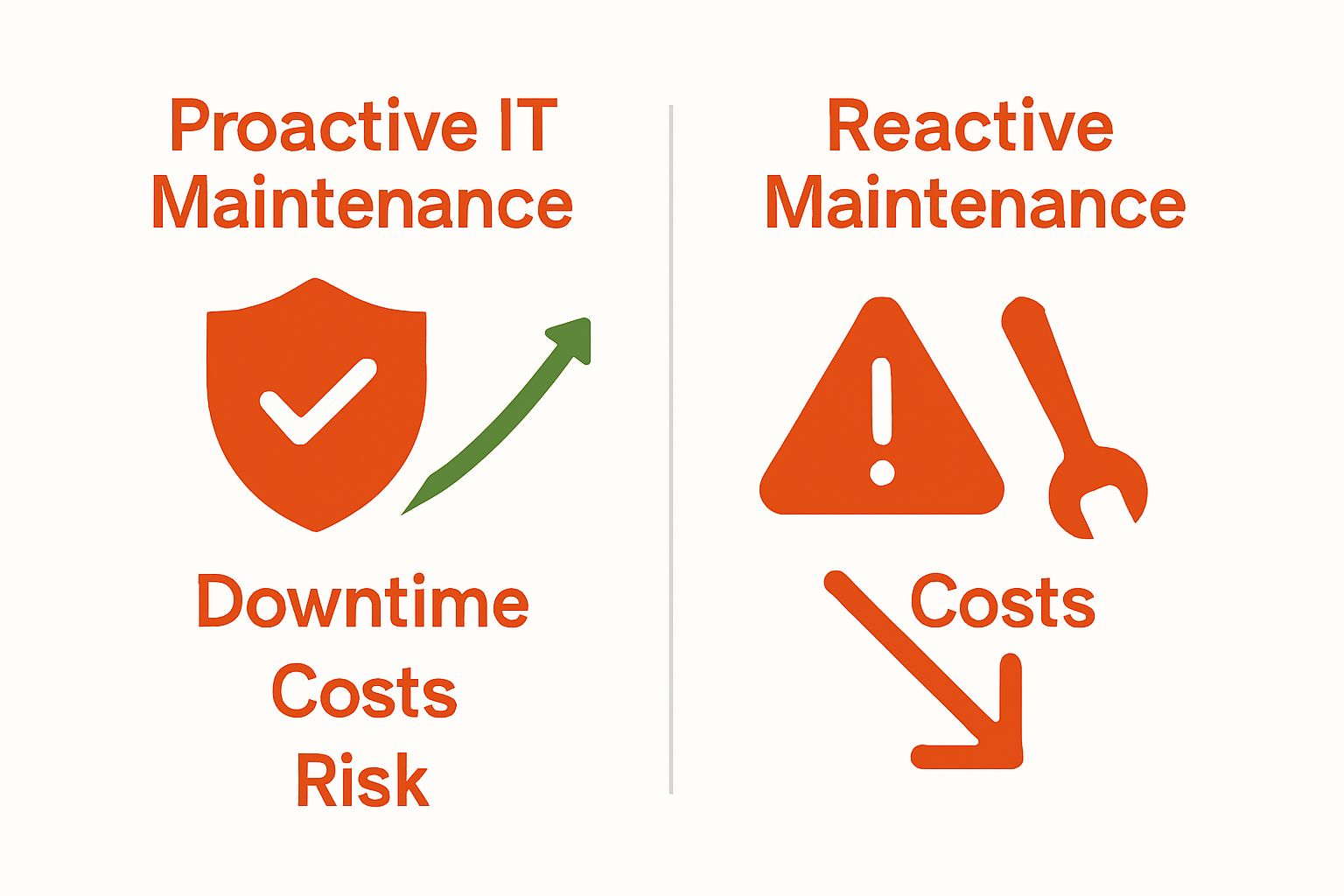
Understanding Proactive IT Maintenance for Businesses
Proactive IT maintenance has become the secret weapon for businesses chasing stability and growth. Most people think IT is all about fixing problems when things fall apart. Yet companies that adopt proactive monitoring can reduce system failures by up to 65 percent and that changes the game completely. Imagine a world where breakdowns barely happen because your tech never gets a chance to fall behind.
Table of Contents
- What Is Proactive It Maintenance?
- The Importance Of Proactive It Maintenance
- The Mechanisms Of Proactive It Maintenance
- Key Principles Of Effective Proactive It Maintenance
Quick Summary
| Takeaway | Explanation |
|---|---|
| Prioritize proactive IT maintenance | Businesses should focus on prevention to avoid system failures and disruptions. |
| Emphasize continuous monitoring | Use advanced tools for real-time system performance tracking and anomaly detection. |
| Invest in predictive analytics | Analyze historical data to foresee and mitigate potential technical issues before they arise. |
| Maintain comprehensive documentation | Keep detailed records of system performance and incidents to facilitate targeted improvements. |
| Adapt IT strategies continuously | Regularly update skills and infrastructure to create an agile and resilient technological environment. |
What is Proactive IT Maintenance?
Proactive IT maintenance represents a strategic approach to managing technology infrastructure that prioritizes prevention over reaction. Instead of waiting for systems to fail, businesses actively monitor, update, and optimize their IT environments to maintain peak performance and minimize potential disruptions.
Core Principles of Proactive Maintenance
At its foundation, proactive IT maintenance involves continuous monitoring and preemptive interventions. According to IBM’s IT infrastructure guidelines, this approach focuses on identifying potential issues before they escalate into significant problems that could compromise business operations.
Key characteristics of proactive IT maintenance include:
- Regular system assessments and performance evaluations
- Scheduled software and hardware updates
- Continuous security vulnerability scanning
- Predictive analysis of potential technical risks
Strategic Benefits for Businesses
Implementing proactive IT maintenance offers substantial advantages for organizations. By understanding how proactive IT management works, businesses can transform their technological infrastructure from a reactive cost center into a strategic asset.
Companies that adopt this approach experience significant improvements in:

- Reduced system downtime
- Lower long-term technology maintenance costs
- Enhanced cybersecurity protection
- Improved overall operational efficiency
Proactive maintenance goes beyond simple troubleshooting. It involves a comprehensive strategy of anticipating, diagnosing, and resolving potential technical challenges before they impact business productivity.
The table below compares the key differences between reactive and proactive IT maintenance approaches to provide a clear understanding of their contrasting outcomes and strategies.
| Aspect | Reactive IT Maintenance | Proactive IT Maintenance |
|---|---|---|
| Approach | Fix issues after they occur | Prevent issues before they arise |
| System Downtime | High risk of unplanned outages | Significantly reduced downtime |
| Cost Implications | Frequent emergency repairs and higher costs | Lower long-term costs through prevention |
| Operational Efficiency | Reactive and often inefficient | Enhanced efficiency and productivity |
| Security | More vulnerable to attacks and breaches | Enhanced continual cybersecurity protection |
| IT Resource Allocation | Unpredictable and stressful workload | Predictable and optimised workload |
| Strategic Value | Viewed as a cost centre | Considered a strategic business asset |
The Importance of Proactive IT Maintenance
Proactive IT maintenance transcends traditional technical support, emerging as a critical strategic investment for businesses seeking sustainable technological resilience. Organizations that embrace this approach transform their IT infrastructure from a potential vulnerability into a robust, adaptive ecosystem.
Financial and Operational Risk Mitigation
Cost reduction becomes a fundamental advantage of proactive maintenance. By identifying and addressing potential technical issues before they escalate, businesses can avoid expensive emergency repairs and extensive system downtime. According to cybersecurity research from the National Institute of Standards and Technology, organizations implementing proactive monitoring reduce potential system failures by up to 65%.
Key financial benefits include:

- Minimizing unexpected repair expenses
- Extending hardware lifecycle
- Reducing productivity losses from system interruptions
- Preventing costly data recovery scenarios
Strategic Technology Performance
Proactive maintenance enables businesses to optimize their technological capabilities continuously. Explore how IT support can transform your operational efficiency and create a more resilient technological infrastructure.
Businesses gain significant strategic advantages through proactive approaches:
- Enhanced system reliability
- Predictable technology performance
- Better resource allocation
- Improved competitive positioning
By treating technology as a dynamic, evolving asset rather than a static resource, organizations can create more responsive, secure, and efficient operational environments. Proactive IT maintenance represents an investment in technological adaptability, ensuring businesses remain agile and prepared for emerging technological challenges.
The Mechanisms of Proactive IT Maintenance
Proactive IT maintenance operates through sophisticated technological and strategic mechanisms designed to anticipate, detect, and resolve potential technical challenges before they disrupt business operations. These intricate processes combine advanced monitoring technologies, predictive analytics, and expert human intervention.
Continuous Monitoring and Performance Tracking
The core mechanism of proactive maintenance involves continuous, real-time system monitoring. Advanced monitoring tools continuously scan IT infrastructure, collecting performance metrics, identifying anomalies, and generating comprehensive reports. According to Gartner’s IT infrastructure research, these systems can detect potential issues with 92% accuracy before they cause significant disruptions.
Key monitoring strategies include:
- Network traffic analysis
- Resource utilization tracking
- Performance baseline establishment
- Automated anomaly detection
Predictive Analysis and Risk Management
Predictive technologies transform raw monitoring data into actionable insights. By employing machine learning algorithms and statistical models, businesses can forecast potential technical failures and system vulnerabilities. Learn more about our comprehensive IT infrastructure lifecycle strategies to understand how predictive analysis works.
Predictive maintenance encompasses several critical components:
- Historical performance data analysis
- Machine learning pattern recognition
- Probabilistic failure prediction
- Proactive maintenance recommendation generation
These mechanisms work synergistically to create a comprehensive, intelligent approach to IT infrastructure management.
The following table summarises core mechanisms involved in proactive IT maintenance, highlighting how each function contributes to a resilient infrastructure.
| Mechanism | Description | Benefit to Business |
|---|---|---|
| Continuous Monitoring | Ongoing system scans and performance tracking | Early anomaly detection and prevention |
| Performance Baseline Establishment | Defining normal operational standards for systems | Accurate identification of irregularities |
| Predictive Analysis | Using statistical models and ML to forecast failures | Proactive issue resolution, reduced risks |
| Scheduled Updates | Regular software and hardware patching | Minimised vulnerabilities and downtime |
| Vulnerability Scanning | Automated detection of security gaps | Enhanced protection against cyber threats |
| Comprehensive Documentation | Systematic record-keeping of incidents and configurations | Enables targeted improvements and reviews |
| Continuous Professional Learning | Keeping IT staff updated with latest trends and technologies | Adaptive and agile infrastructure |
Key Principles of Effective Proactive IT Maintenance
Proactive IT maintenance is not merely a technical process but a strategic framework requiring disciplined implementation and sophisticated understanding. Organizations must develop robust methodologies that transform technological management from reactive troubleshooting to intelligent, anticipatory intervention.
Systematic Assessment and Documentation
Comprehensive documentation forms the foundational principle of effective proactive maintenance. According to international IT infrastructure standards, systematic record-keeping enables organizations to track system performance, identify recurring issues, and develop targeted improvement strategies.
Key documentation practices include:
- Detailed system configuration records
- Performance baseline documentation
- Incident and resolution logs
- Regular technological asset inventories
Continuous Learning and Adaptive Strategies
Proactive maintenance demands a dynamic, evolving approach that integrates technological intelligence with human expertise. Explore our comprehensive service agreement options to understand how adaptive IT strategies can transform your technological infrastructure.
Critical adaptive principles encompass:
- Regular skills upgrading for IT professionals
- Continuous technology trend monitoring
- Flexible infrastructure design
- Rapid response protocol development
By embracing these principles, organizations can create a resilient, intelligent IT ecosystem that anticipates challenges, minimizes disruptions, and transforms technological infrastructure from a potential liability into a strategic competitive advantage.
Transform IT Maintenance Challenges into Business Growth with Techtron
Are recurring disruptions and unexpected IT costs holding your business back? The article highlights how waiting for technology problems can lead to expensive repairs, security risks and lost productivity. You need a partner who embraces proactive IT maintenance to keep your team focused and your systems reliable. With Techtron’s managed IT solutions, your business benefits from real-time monitoring, predictive analysis, and rapid support that eliminate surprises and safeguard your operations.
Now is the time to take control of your IT environment and avoid the stress of unforeseen failures. Experience proactive support designed for professional firms in South Africa by visiting our main site. Discover how our tailored approach can unlock efficiency and peace of mind for your organisation today.
Frequently Asked Questions
What are the key benefits of proactive IT maintenance for businesses?
Proactive IT maintenance helps businesses reduce system downtime and lower long-term maintenance costs. By implementing this approach, organizations can improve operational efficiency and enhance cybersecurity protection, leading to more reliable technology performance.
How can my business implement proactive IT maintenance effectively?
To implement proactive IT maintenance, start by establishing continuous monitoring of your IT infrastructure. Schedule regular system assessments and update your hardware and software proactively, which helps identify potential issues early and mitigates risks within your systems.
What types of monitoring are essential in proactive IT maintenance?
Essential monitoring types include network traffic analysis, resource utilization tracking, and automated anomaly detection. Utilize these monitoring strategies to create a comprehensive view of your IT environment and detect issues with a high degree of accuracy.
How does predictive analysis contribute to proactive IT maintenance?
Predictive analysis allows businesses to anticipate potential failures by analyzing historical performance data and recognizing patterns. Implementing this analysis can significantly reduce unplanned outages, boosting operational resilience and performance.
What documentation practices should I follow for effective proactive IT maintenance?
Effective documentation practices include maintaining detailed records of system configurations, performance baselines, and incident logs. Establish a regular review process, which helps track performance over time and identify areas for targeted improvements.
How does continuous learning play a role in proactive IT maintenance?
Continuous learning ensures that IT professionals are equipped with the latest knowledge and skills to respond to emerging technologies and trends. Encourage regular training and development to adapt strategies effectively, enhancing your organization’s IT capabilities.